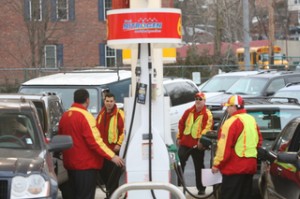Expect to pay less for gasoline this summer than you did a year ago – but just barely, says the U.S. Department of Energy.
The Energy Information Administration predicts the typical American motorist will shell out $3.57 for a gallon of self-serve no-lead gasoline, a penny per gallon cheaper than during the April to September period last year.
“That’s essentially the same number,” said EIA Administrator Adam Sieminski during a conference call with reporters. But the good news is that this will be the lowest fuel price motorists have paid since 2010 during the period when driving peaks in the U.S.
Don’t be surprised to see fuel prices start to rise in the coming weeks as the weather warms and motorists start clocking more mileage. That’s likely to be particularly true in the Midwest and other parts of the country just seeing the last of a harsh winter’s snow melt away. Prices are then expected to dip for the rest of the extended summer season.
Prices are impacted by a variety of factors, including consumer demand in the U.S. But petroleum futures are increasingly linked to usage abroad, particularly in booming market like China, India and Brazil.
On the other hand, there’s been a surge in production, especially in North America, the U.S. less dependent upon Mideast oil supplies than at any time in recent decades. That has been helping to offset any increased demand overseas. Significantly, Brent crude, the benchmark used for pricing oil in much of the world, is expected to see a 4% decline in price this year.
But other factors, including an expansion of the current Ukranian crisis, or a renewed flare-up of Mideast violence, could shift the current forecast for U.S. fuel prices.
Barring a major crisis, however, the EIA anticipates that fuel prices for all of 2014 will dip to an average $3.45 a gallon, down from $3.51 last year – and also the lowest figure since 2010.
Fuel prices will almost certainly vary depending upon where you tank up, the Energy Dept. cautioned, its website noting “significant differences across regions, with monthly average prices in some areas exceeding the national average price by 30 cents/gal or more.”
(Tennessee’s anti-union approach may stall plans to expand VW plant. For more, Click Here.)
Indeed, residents of Montana are currently paying just $3.286, on average, for no-lead, according to tracking site GasBuddy.com, while those in Hawaii are pumping gas priced at $4.288. On the mainland, the peak is in California, at $4.047.
(Click Here for details about Bridgestone’s new run-flat replacement tires.)
The service shows a current national average of $3.570, up from $3.544 a week ago, but down a half-cent compared to the price of $3.575 at this time last year.
Motorists typically clock more mileage during the summer months, and there’s been a historic, year-over-year increase in travel since the government first began keeping records. But that trend has been slowing in recent years, and even shown signs of reversing. Meanwhile, any increases in travel, said the EIA, have been “offset by an increase in fleet-wide fuel efficiency.”
(To see more about Hyundai’s plans to challenge the BMW 3-Series, Click Here.)
The increase in efficiency has been leading many Americans to switch from gas power to alternatives. A recent study, for example, found that U.S. motorists saved about $300 million with their electric vehicles in 2013.
Meanwhile, a growing number of buyers are opting for diesel vehicles which typically yield about 25% better mileage than comparable, gas-powered vehicles. But there is a penalty. According to the EIA, diesel fuel prices are expected to average about $3.87 this summer. But that’s about 2 cents less than during the summer of 2013.


Massively over-priced crude has done a good job of wrecking world economies for going on six years now.